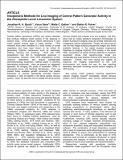Files in this item
Inexpensive methods for live imaging of central pattern generator activity in the Drosophila larval locomotor system
Item metadata
| dc.contributor.author | Booth, Jonathan | |
| dc.contributor.author | Sane, Varun | |
| dc.contributor.author | Gather, Malte C. | |
| dc.contributor.author | Pulver, Stefan R. | |
| dc.date.accessioned | 2021-02-08T16:30:29Z | |
| dc.date.available | 2021-02-08T16:30:29Z | |
| dc.date.issued | 2020-12-31 | |
| dc.identifier | 272470275 | |
| dc.identifier | 5eb8bea2-784b-4f37-8720-f7176cacbad6 | |
| dc.identifier.citation | Booth , J , Sane , V , Gather , M C & Pulver , S R 2020 , ' Inexpensive methods for live imaging of central pattern generator activity in the Drosophila larval locomotor system ' , Journal of Undergraduate Neuroscience Education , vol. 19 , no. 1 , pp. A124-A133 . < https://www.funjournal.org/wp-content/uploads/2021/01/june-19-124.pdf?x89760 > | en |
| dc.identifier.issn | 1544-2896 | |
| dc.identifier.other | ORCID: /0000-0002-4857-5562/work/87404209 | |
| dc.identifier.other | ORCID: /0000-0001-5170-7522/work/87404252 | |
| dc.identifier.uri | https://hdl.handle.net/10023/21389 | |
| dc.description | This work was supported by EPSRC Doctoral Training grant EP/L505079/1) and a European Research Council Grant to MCG (640012) It was also supported by a British Council GREAT Scholarship (to VS) as well as grants from the St Andrews Learning and Teaching Initiative and the McCall-McBain Foundation to SRP. This work was also supported by the open source DIY communities as described throughout the paper. | en |
| dc.description.abstract | Central pattern generators (CPGs) are neural networks that produce rhythmic motor activity in the absence of sensory input. CPGs produce ‘fictive’ behaviours in vitro which parallel activity seen in intact animals. CPG networks have been identified in a wide variety of model organisms and have been shown to be critical for generating rhythmic behaviours such as swimming, walking, chewing and breathing. Work with CPG preparations has led to fundamental advances in neuroscience; however, most CPG preparations involve intensive dissections and require sophisticated electrophysiology equipment, making export to teaching laboratories problematic. Here we present an integrated approach for bringing the study of locomotor CPGs in Drosophila larvae into teaching laboratories. First, we present freely available genetic constructs that enable educators to express genetically encoded calcium indicators in cells of interest in the larval central nervous system. Next, we describe how to isolate the larval central nervous system and prepare it for live imaging. We then show how to modify standard compound microscopes to enable fluorescent imaging using 3D printed materials and inexpensive optical components. Finally, we show how to use the free image analysis programme ImageJ and freely available features in the signal analysis programme DataView to analyse rhythmic CPG activity in the larval CNS. Comparison of results to those obtained on research equipment shows that signal-to-noise levels are comparable and core features of larval CPG activity can be observed. Overall, this work shows the viability of exporting live imaging experiments to low cost environments and paves the way for new teaching laboratory exercises revolving around optical imaging of CPG activity. | |
| dc.format.extent | 4012683 | |
| dc.language.iso | eng | |
| dc.relation.ispartof | Journal of Undergraduate Neuroscience Education | en |
| dc.subject | Motor systems | en |
| dc.subject | Teaching equipment | en |
| dc.subject | Calcium imaging | en |
| dc.subject | GcamP | en |
| dc.subject | Drosophilia | en |
| dc.subject | Central nervous system | en |
| dc.subject | Larval locomotion | en |
| dc.subject | Open source | en |
| dc.subject | Epifluorescence | en |
| dc.subject | QC Physics | en |
| dc.subject | RC0321 Neuroscience. Biological psychiatry. Neuropsychiatry | en |
| dc.subject | DAS | en |
| dc.subject.lcc | QC | en |
| dc.subject.lcc | RC0321 | en |
| dc.title | Inexpensive methods for live imaging of central pattern generator activity in the Drosophila larval locomotor system | en |
| dc.type | Journal article | en |
| dc.contributor.sponsor | European Research Council | en |
| dc.contributor.institution | University of St Andrews. School of Physics and Astronomy | en |
| dc.contributor.institution | University of St Andrews. Sir James Mackenzie Institute for Early Diagnosis | en |
| dc.contributor.institution | University of St Andrews. Centre for Biophotonics | en |
| dc.contributor.institution | University of St Andrews. Biomedical Sciences Research Complex | en |
| dc.contributor.institution | University of St Andrews. School of Psychology and Neuroscience | en |
| dc.description.status | Peer reviewed | en |
| dc.identifier.url | https://www.funjournal.org/current-issue/ | en |
| dc.identifier.url | https://www.funjournal.org/wp-content/uploads/2021/01/june-19-124.pdf?x89760 | en |
| dc.identifier.grantnumber | 640012 | en |
This item appears in the following Collection(s)
Items in the St Andrews Research Repository are protected by copyright, with all rights reserved, unless otherwise indicated.

